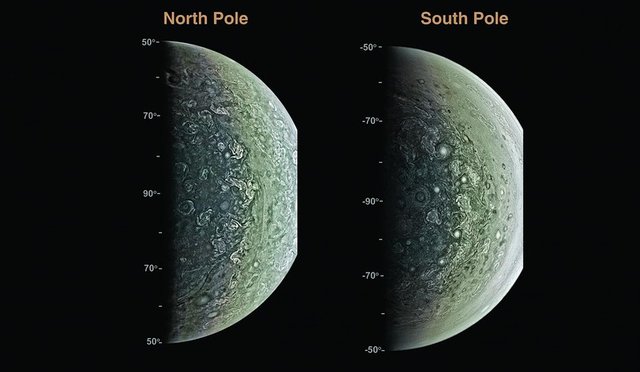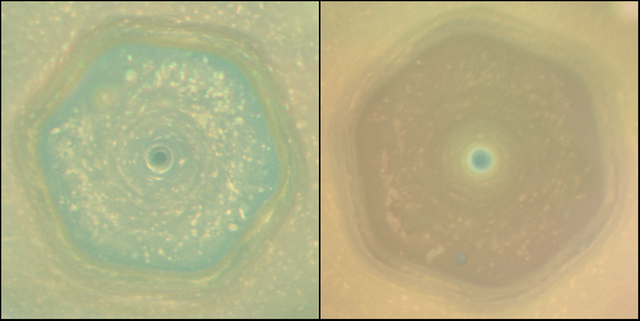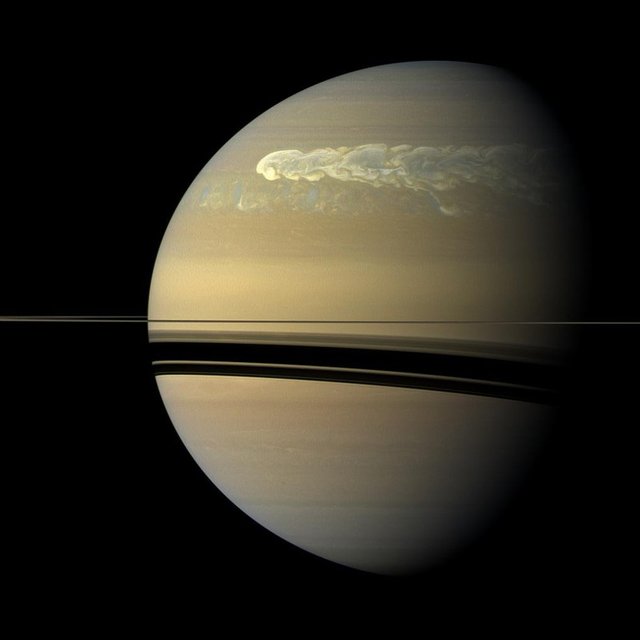Many theories about Jupiter inner structure and climate will have to be rewritten, as new data are obtained from Juno spacecraft, orbiting Jupiter since 4 July 2016.

Image: J.E.P. Connerney et al., Science (2017) Poles of Jupiter, imaged by Juno
Juno revealed surprising fact that famous Jupiter's signature bands disappear near its poles, giving place to chaotic scene of swirling storms up to size of Earth's Moon or even Mars.
Juno's microwave sounding instrument reveals that topical weather phenomena extend deep below the cloudtops, to pressures of 100 bars, 100 times Earth's air pressure at sea level.

Image: (NASA/JPL-Caltech/SwRI/MSSS/Betsy Asher Hall/Gervasio Robles via AP) - The oval features are cyclones, up to 1000 kilometers in diameter. The cyclones are separate from Jupiter's trademark Great Red Spot, a raging hurricane-like storm south of the equator.
Another surprise - Juno's measurements of Jupiter's gravity and magnetic fields. Dr. Scott Bolton, Juno's principal investigator said:
Juno's gravity field measurements differ significantly from what we expected, which has implications for the distribution of heavy elements in the interior, including the existence and mass of Jupiter's core. The magnitude of the observed magnetic field was 7.766 Gauss, significantly stronger than expected. But the real surprise was the dramatic spatial variation in the field, which was significantly higher than expected in some locations, and markedly lower in others. .... We characterized the field to estimate the depth of the dynamo region, suggesting that it may occur in a molecular hydrogen layer above the pressure-induced transition to the metallic state.
The current theory of Jupiter's inner structure suggests, that central core of the giant planet consists of molecular hydrogen in metallic state, surrounded by dynamo—a rotating, convecting, electrically conducting fluid in a planet's outer core, generating the planetary magnetic fields. Obviously, new data will change this theory.
Meanwhile, another NASA mission - Cassini, completing its 13 years long job on the Saturn's orbit, observes solstice in the Saturn's northern hemisphere. Saturn's solstice—that is, the longest day of summer in the northern hemisphere and the shortest day of winter in the southern hemisphere—arrives today for the planet and its moons.

Image: NASA/JPL-Caltech/SSI/Hampton University - These natural color views from Cassini show how the color of Saturn's north-polar region changed between June 2013 and April 2017, as the northern hemisphere headed toward summer solstice
Reaching the solstice, and observing seasonal changes in the Saturn system along the way, was a primary goal of Cassini Solstice Mission, which began in 2010.
During its Solstice Mission, Cassini watched a giant storm erupt and encircle the planet. The spacecraft also saw the disappearance of bluer hues that had lingered in the far north as springtime hazes began to form there. The hazes are part of the reason why features in Saturn's atmosphere are more muted in their appearance than those on Jupiter.

Image: NASA/JPL-Caltech/Space Science Institute - During its seven-year Solstice Mission, Cassini watched as a huge storm erupted and encircled Saturn in several days
Researchers were surprised that the changes occur suddenly, at specific latitudes in Saturn's banded atmosphere. "Eventually a whole hemisphere undergoes change, but it gets there by these jumps at specific latitude bands at different times in the season," said Robert West, a Cassini imaging team member at JPL
Sources:
https://phys.org/news/2017-05-juno-mission-jupiter-science-results.html